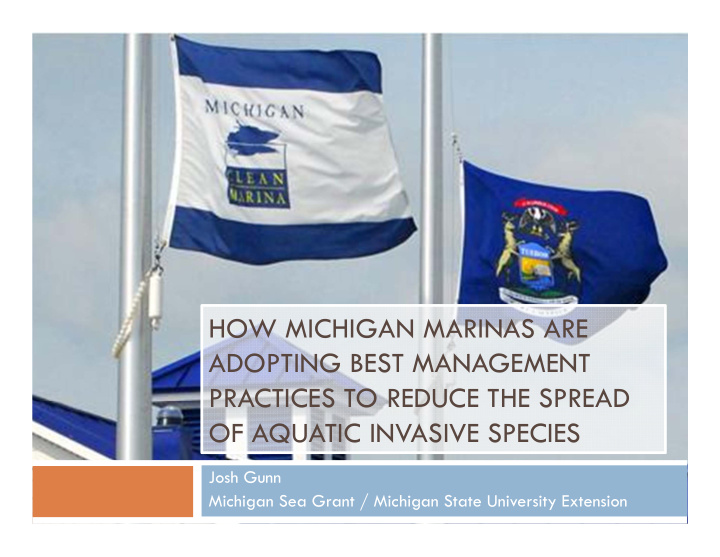



HOW MICHIGAN MARINAS ARE ADOPTING BEST MANAGEMENT PRACTICES TO REDUCE THE SPREAD OF AQUATIC INVASIVE SPECIES Josh Gunn Michigan Sea Grant / Michigan State University Extension
Goal of AIS BMPs in Marinas Over 11,000 inland • lakes over 5 acres Majority of AIS is in • Great Lakes, and difficulty is preventing spread into inland lakes Another concern is • the spread among inland lakes
Small Public Harbors, Municipal Marinas, Private Marinas Accommodation Practices Installed public boat wash station Portable boat wash station Parking area to inspect and clean boat Education Practices Signage Training Clean Boats Clean Waters Program
Community-based program where volunteers go to parks, harbors, and public marinas to educate boaters and demonstrate proper ways to inspect boats and trailers Michigan Lakes and Streams Association is taking an increasing role in the Clean Boats Clean Waters Program due to the increase in participation on inland lakes
Large Privately Owned Marinas Maintenance services (like boat bottom pressure washing) provided at larger marinas may be classified as an industrial activity and the facility must comply with DEQ requirement for not discharging wastewater directly into sewer system or into surface water There are different systems in use in Michigan to handle boatwash wastewater prior to discharge or transfer into a storage tank: Filtration systems Settling systems Closed-loop recycling systems Disclaimer: Use of the mentioned systems does not ensure compliance with Michigan DEQ requirements and Clean Water Act Regulations; please contact DEQ, local municipality, and/or consultant prior to selecting an appropriate boat wash technology
Typical Permanent Boat Washing Station Design Two Key Factors: 1. When boat washing is being conducted, all wastewater goes to storage or municipal sewer 2. When boat washing is not being conducted, stormwater cannot go into municipal sewer NOTE: if design results in stormwater overflow, it is considered a point source and additional permits beyond a Stormwater Discharge Permit may be required
Boat Wash Technologies: Installed public boat wash stations Lake Associations and Municipal Marinas showing interest in installing or retrofitting these into their facility Unless washing is done prior to boat going into lake, it only prevents removal of AIS
Boat Wash Technologies: Portable boat wash stations Can be packed up if space is an issue Cheaper than a permanent station Photos: Steve Kohls, Brainerd Dispatch
Boat Wash Technologies: Filtration systems Sewer filtration systems need maintenance (cleaning and/or replacing)
Boat Wash Technologies: Settling Systems Allows larger organics and particulates to settle prior to pumping into sewer or storage Can include larger settling basins that go deeper into the ground before discharge into tank or sewer
Boat Wash Technologies: Recycling systems Closed system designed to reduce the quantity of water used Filtration and treatment of water Potentially higher maintenance cost If chemically treated, water will still need to be properly disposed of at end of season
Another commonly heard suggestion… Take this To this
For More Information: Under The Great Lakes Restoration Initiative, The Green Marina Education and Outreach Project has worked to educate marinas, boaters, and the public on AIS and boat bottom washing Regional BMP guide to assist Great Lakes Marinas in adopting BMPs that reduce the transfer of AIS from one body of water to another A previous Clean Marina Webinar was held on boat wash practices webpage of past presentations: http://www.miseagrant.umich.edu/greenmarina/boatwash/index.html
Josh Gunn Michigan Sea Grant Extension Educator Michigan Clean Marina Coordinator Phone: (586)469-6087 Email: gunnjosh@msu.edu
Recommend
More recommend